
Oakland is the academic and healthcare center of Pittsburgh and one of the city's major cultural centers. Home to three universities, museums, hospitals, shopping venues, restaurants, and recreational activities, this section of the city also includes two city-designated historic districts: the mostly residential Schenley Farms Historic District and the predominantly institutional Oakland Civic Center Historic District, as well as the locally-designated Oakland Square Historic District.

Schenley Park is a large municipal park in Pittsburgh, Pennsylvania, United States. It is located between the neighborhoods of Oakland, Greenfield, and Squirrel Hill. It is also listed on the National Register of Historic Places as a historic district. In 2011, the park was named one of "America's Coolest City Parks" by Travel + Leisure.

Phipps Conservatory and Botanical Gardens is a botanical garden set in Schenley Park, Pittsburgh, Pennsylvania, United States. It is a City of Pittsburgh historic landmark and is listed on the National Register of Historic Places.

Schenley Plaza is a public park serving as the grand entrance into Schenley Park in Pittsburgh, Pennsylvania.
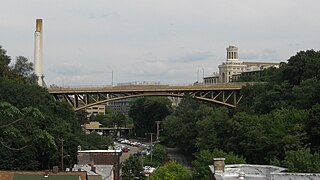
The Schenley Bridge is a steel three-hinged deck arch bridge spanning Junction Hollow in Pittsburgh, Pennsylvania. It carries Schenley Drive between Oakland on the west and the main part of Schenley Park on the east, connecting Schenley Plaza, the Carnegie Institute, and the Frick Fine Arts Building with Frew Street, Flagstaff Hill, and Phipps Conservatory. The bridge spans 620 feet (190 m) and arches 120 feet (37 m) above the hollow.

The Panther Hollow Bridge is an American steel, three-hinged, deck arch bridge that carries Panther Hollow Road over Panther Hollow in Schenley Park in Pittsburgh, Pennsylvania.
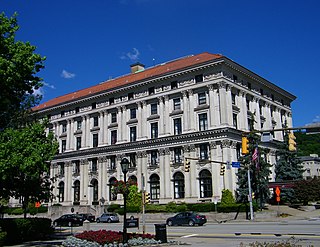
The Pittsburgh Athletic Association at the University of Pittsburgh is a historic, Benno Janssen designed building located in Pittsburgh, Pennsylvania. Opened as the home of a private social and athletic club of the same name, the building is listed on the National Register of Historic Places.

A panther is the animal that serves as the official mascot of the University of Pittsburgh and used as a nickname for both athletic teams as well as other organizations and affiliates of the university. The mascot is generally referred to as the Pittsburgh Panther or Pitt Panther, while the costumed panther mascot is also named "Roc". Up to 20 physical representations of panthers can be found in and around the university's campus and athletic facilities.

The Schenley Park Casino was Pittsburgh’s first multi-purpose arena. The facility was considered the envy of the sports and entertainment world during the early 1890s, with amenities that were unsurpassed anywhere on the globe. It was built at the entrance to Schenley Park in Oakland near the Phipps Conservatory, the Schenley Bridge and the Carnegie Library of Pittsburgh. The University of Pittsburgh’s Frick Fine Arts Building currently sits on the site of the casino. The casino was the first place in Pittsburgh where organized ice hockey was played. The arena's artificial ice surface was the first of its kind in North America.
The Pittsburgh Athletic Club (PAC) was one of the earliest professional ice hockey teams. It was based in Pittsburgh, Pennsylvania from around 1895 until 1905 and again from 1907 to 1909.
Frank S. Curto was the chief horticulturist for the Pittsburgh Department of Parks and Recreation.
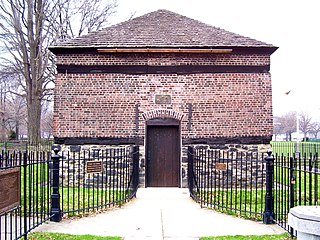
The Fort Pitt Block House is a historic building in Point State Park in the city of Pittsburgh. It was constructed in 1764 as a redoubt of Fort Pitt, making it the oldest extant structure in Western Pennsylvania, as well as the "oldest authenticated structure west of the Allegheny Mountains".
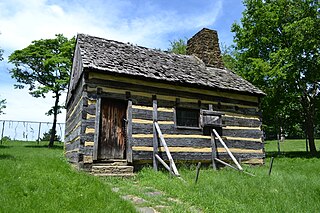
The Neill Log House is a historic log cabin in Schenley Park in Pittsburgh, Pennsylvania, United States. It was built during the second half of the 18th century and has been most commonly attributed to Robert Neill (Neal), with an estimated construction date possibly anywhere from 1765 to 1795. This estimate is based on architectural evidence as well as the large increase in value of the land during Neill's period of ownership which would indicate he made substantial improvements. However, the earlier date of 1765 claimed in some sources, would associate the building with an earlier landowner, Ambrose Newton. In 2024, a dendrochronology study determined that the beam over the fireplace, believed to be original to the house's construction, was dated to be from 1795, which was the date that Robert Neal sold the cabin to John Reed. It is known by records that Robert Neal purchased the land in 1779 and sold the cabin and land in 1795. Extrapolation of the known dates of Robert Neal's purchase and date the property was sold and the large increase in value during Robert Neal's ownership indicating he made substantial improvements likely mean it may have been built by him between 1779-1794.
The following is a timeline of the history of the city of Pittsburgh, Pennsylvania, US.

Panther Hollow Lake is a human-made lake in Schenley Park in Pittsburgh, Pennsylvania.

The Westinghouse Memorial is a bronze monument located in the U.S. city of Pittsburgh, Pennsylvania. It commemorates George Westinghouse, an engineer, founder of the Westinghouse Electric Corporation, and inventor of the railway air brake. The memorial is located at the entrance to the Steven Faloon trail, a part of Schenley Park. The architects for the monument and the surrounding area were Henry Hornbostel and Eric Fisher Wood. Daniel Chester French was the sculptor for the statue and the main panel, and Paul Fjelde designed the side panels.

The Greenfield Bridge, officially known as the Beechwood Boulevard (Greenfield) Bridge II, is a steel arch bridge located in Pittsburgh, Pennsylvania, United States. The bridge connects the neighborhoods of Greenfield and Squirrel Hill across the valley known as Four Mile Run which separates them. The bridge also spans the Parkway East (I-376), which runs along the bottom of the valley.

The Former Pittsburgh Wash House and Public Baths Building is located at 3495 Butler Street in the Lawrenceville neighborhood of Pittsburgh, Pennsylvania. Built in 1904 in the Romanesque Revival architectural style, the building today serves as office space. The bath house was designated a Pittsburgh historic landmark in 2018 and was listed as a contributing property in the Lawrenceville Historic District in 2019.

The Catahecassa (Snyder) Spring is located at the intersection of E. Circuit Road and Serpentine Drive in Schenley Park in Pittsburgh, Pennsylvania. The spring was built in 1906–1907 and is one of only three remaining springs within the city.
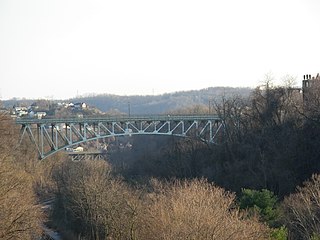
The Charles Anderson Memorial Bridge is a steel deck truss bridge located in Pittsburgh, Pennsylvania, United States. The bridge carries the four-lane roadway of Boulevard of the Allies across a ravine known as Junction Hollow, connecting the neighborhoods of Central Oakland and South Oakland with Schenley Park. The bridge also spans the Junction Hollow Trail and P&W Subdivision railroad tracks which run along the bottom of the valley.




















